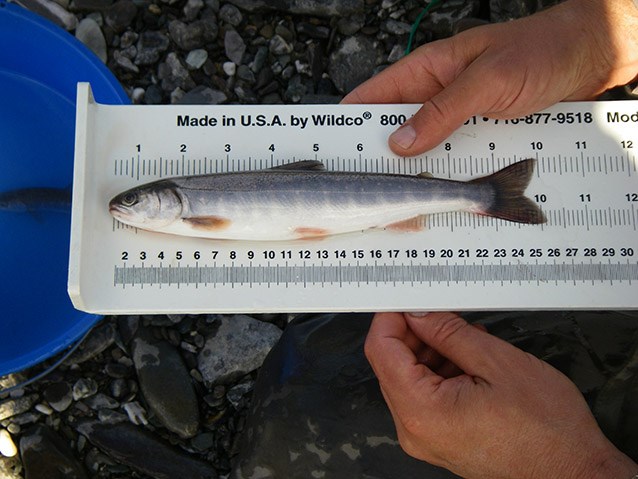Part of a series of articles titled Alaska Park Science - Volume 16 Issue: Science in Alaska's Arctic Parks.
Article
Potential Effects of Permafrost Thaw on Arctic River Ecosystems
By Jonathan A. O’Donnell, National Park Service and Christian E. Zimmerman, Michael P. Carey, and Joshua C. Koch, U.S. Geological Survey, Alaska Science Center
While it is relatively easy to pose this question, detecting the effects of permafrost thaw on river ecosystems is complicated. Permafrost thaw in Arctic watersheds presents a complex problem requiring expertise in geophysics, hydrology, chemistry, and biology.How will fish populations in Arctic streams respond to climate change and permafrost thaw?

NPS Photo / Ken Hill
Physical Effects of Permafrost Thaw on Rivers
Permafrost is ground that remains frozen year-round, and occurs in cold climates at high latitudes and altitudes. Recent warming in the Arctic is driving widespread thawing of permafrost, which can have a profound impact on watershed hydrology (Figure 1). Thawing of ground ice may alter stream and river discharge (Walvoord and Kurylyk 2016) and the location and magnitude of stream inflows (Koch et al. 2013). Permafrost thaw in ice-rich terrain can cause the formation of thermokarst features, or depressions associated with melting of ground ice and subsidence of the ground surface. In many cases, thermokarst can lead to erosion of soils from terrestrial uplands followed by deposition into rivers and lakes. These effects of permafrost thaw can alter the physical structure of streams and rivers, which can improve or deteriorate habitat for fish and other aquatic organisms.

Effects of Permafrost Thaw on Water Quality
Permafrost thaw also plays an important role in water quality in rivers and lakes. Soils in the northern permafrost region store large amounts of organic carbon – nearly twice the amount currently stored in the atmosphere (Hugelius et al. 2014). Much of this carbon has been locked away for thousands of years in the permafrost, which essentially functions like a freezer for carbon.
When permafrost thaws, a fraction of this old carbon can be released to the atmosphere as carbon dioxide or methane gas, accelerating climate warming. A smaller fraction of this thawed, old carbon can also be released to aquatic ecosystems as dissolved or particulate organic matter (O’Donnell et al. 2014), affecting water clarity, acidity, and trace metal transport (such as mercury) to streams. Permafrost soils also store large amounts of nitrogen (Harden et al. 2012) and other nutrients. Following thaw, this nitrogen can act to “fertilize” ecosystems, creating bigger, greener plants and more algae in streams.
Effects of Permafrost Thaw on Freshwater Fish
Changing hydrology and stream chemistry associated with permafrost thaw will likely impact fish in Arctic rivers. While climate change may directly affect fish by increasing stream temperature, permafrost thaw will likely affect fish indirectly by altering different components of the stream food web. For instance, the slow release of nutrients from thawing permafrost can increase algal growth on sediments, influence stream invertebrate (e.g., insect larvae) composition and productivity, and fish size (Slavik et al. 2004). Thermokarst (irregular topography resulting from ground ice melting) can also increase the amount of solids transported in stream flow, which can negatively impact stream invertebrates (Chin et al. 2016), an important food source for many fish.
Despite these and other recent advances in our understanding of thaw effects on aquatic ecosystems (Vonk et al. 2015), gaps remain in our understanding of the potential effects of permafrost thaw on fish habitat, behavior, and productivity.
The Hydro-Ecology of Arctic Thaw (HEAT) Project
In the summer of 2015, we began a five-year project aimed at understanding the effects of permafrost thaw on aquatic ecosystems and fish that we call the HEAT (Hydro-Ecology of Arctic Thaw) project. This project is a collaboration between the NPS Arctic Inventory and Monitoring Network and U.S. Geological Survey (USGS) Changing Arctic Ecosystems Initiative, an effort to better understand biotic response to a warming climate (Van Hemert et al. 2015). An important goal of the HEAT project is to document linkages among hydrology, water chemistry, and fish ecology in a landscape undergoing dramatic change. We established study sites in the Agashashok River basin, a large tributary of the Noatak River in northwest Alaska.
The Agashashok River is situated in the Arctic-boreal transition zone, a region undergoing rapid landscape change associated with a warming climate and thawing permafrost (Panda et al. 2017). We sampled 12 small headwater streams, where terrestrial ecosystems most strongly influence aquatic ecosystems. These streams drain watersheds that vary according to permafrost characteristics (ground ice, soil temperature) and vegetation (boreal forest or tundra).
We collected a broad range of samples and measurements in the field to understand hydrology, water quality, and food-web dynamics across this changing landscape. We collected water samples from all streams and analyzed for carbon, nutrient, and other mineral solute concentrations. We measured stream discharge across the hydrograph to quantify the magnitude and seasonality of stream flow. We scraped algae off rocks on streambeds to measure chlorophyll content of primary producers. We also collected stream invertebrates from sediments to quantify the abundance and diversity of invertebrates in our study streams.
We sampled Arctic Grayling (Thymallus arcticus) and Dolly Varden (Salvelinus malma; Figure 2) throughout the drainage, although their abundance and distribution varied across study streams. We are also using stable isotopes and radiocarbon isotopes to understand food-web dynamics in these streams. Radiocarbon measurements can be used to detect the incorporation of old carbon released from thawing permafrost into the aquatic food web.

NPS Photo / Jonathan O'Donnell
Acknowledgements
This work was part of the USGS Changing Arctic Ecosystem Initiative and was supported by the Wildlife Program of the USGS Ecosystems Mission Area. Additional support was provided by the NPS Arctic Inventory and Monitoring Network, and by the Terrestrial Ecosystem Observing Network of the U. S. Fish and Wildlife Service Arctic Land Conservation Cooperative. We thank John Pearce and Grant Hilderbrand for comments that improved this manuscript.References
Chin, K. S., J. Lento, J. M. Culp, D. Lacelle, and S. V. Kokelj. 2016.Permafrost thaw and intense thermokarst activity decreases abundance of stream benthic macroinvertebrates. Global Change Biology, doi:10.1111/gcb.13225.
Harden, J. W., C. D. Koven, C. L. Ping, G. Hugelius, A. D. McGuire, P. Camill, T. Jorgenson, P. Kuhry, G. J. Michaelson, J. A. O’Donnell, E. A. G. Schuur, C. Tarnocai, K. Johnson, and G. Grosse. 2012.
Field information links permafrost carbon to physical vulnerabilities of thawing. Geophysical Research Letters 39, doi:10.1029/2012GL051958.
Hugelius, G., J. Strauss, S. Zubrzycki, J. W. Harden, E. A. G. Schuur, C. L. Ping, L. Schirrmeister, G. Grosse, G. J. Michaelson, C. Koven, J. A. O’Donnell, B. Elberling, U. Mishra, P. Camill, Z. Yu, J. Palmtag, and P. Kuhry. 2014.
Estimated stocks of circumpolar permafrost carbon with quantified uncertainty ranges and identified data gaps. Biogeosciences 11:6573-6593, doi:10.5194/bg-11-6573-2014.
Koch, J. C., S. A. Ewing, R. Striegl, and D. M. McKnight. 2013.
Rapid runoff via shallow throughflow and deeper preferential flow in a boreal catchment underlain by frozen silt (Alaska, USA). Hydrogeology Journal 21(1):93-106.
O’Donnell, J. A., G. R. Aiken, M. A. Walvoord, P. A. Raymond, K. D. Butler, M. M. Dornblaser, and K. Heckman. 2014.
Using dissolved organic matter composition and age to detect permafrost thaw in boreal streams of interior Alaska. Journal of Geophysical Research – Biogeochemistry 119, doi:10.1002/2014JG002695.
Panda, S. K., V. E. Romanovsky, S. S. Marchenko, and D. K. Swanson. 2017.
The fate of permafrost. Alaska Park Science 16(1):39-45.
Slavik, K., B. J. Peterson, L. A. Deegan, W. B. Bowden, A. E. Hershey, and J. E. Hobbie. 2004.
Long-term responses of the Kuparuk River ecosystem to phosphorus fertilization. Ecology 85:939-954.
Van Hemert, C. R., P. L. Flint, M. S. Udevitz, J. C. Koch, T. C. Atwood, K. L. Oakley, and J. M. Pearce. 2015.
Forecasting wildlife response to rapid warming in the Alaskan Arctic. BioScience 65:718-728, doi:10.1093/biosci/biv069
Vonk, J. E., S. E. Tank, W. B. Bowden, I. Laurion, W. F. Vincent, P. Alekseychik, M. Amyot, M. F. Billet, J. Canario, R. M. Cory, B. N. Deshpande, M. Helbig, M. Jammet, J. Karlsson, J. Larouche, G. MacMillan, M. Rautio, K. M. Walter Anthony, and K. P. Wickland. 2015.
Review and synthesis: effects of permafrost thaw on Arctic aquatic ecosystems. Biogeosciences 12:7129-7167, doi:10.5194/bg-12-7129-2015.
Walvoord, M. A., and B. L. Kurylyk. 2016.
Hydrologic impacts of thawing permafrost – A review. Vadose Zone Journal 15, doi:10.2136/vzj2016.01.0010.
Last updated: April 6, 2017
